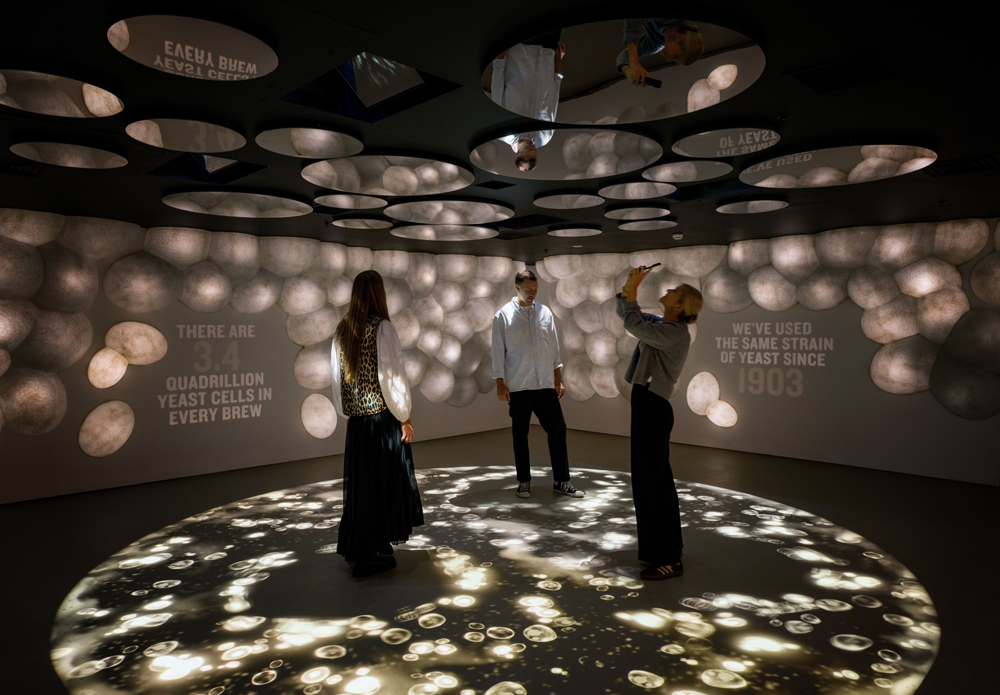
Guinness Storehouse has relaunched the Yeast Room as part of the Ingredients Experience at the iconic Guinness Storehouse in Dublin, with an innovative new immersive design concept by global strategy and design studio Dalziel & Pow.
The award-winning Guinness Storehouse, which turns 25 this year, gives visitors the chance to experience the history and storytelling behind Ireland’s most iconic stout, and has accommodated more than 26 million visitors since opening.
The space takes visitors on a magical journey, telling the story of four natural ingredients – barley, water, hops and yeast – that are used to create Guinness. Each Ingredients Experience space, designed by Dalziel & Pow, represents the ingredients with artistic, interactive installations, including a 1,000 sq. metre field of real barley and a world-first 14m water curtain.
Following the huge success of the Ingredients Experience, which opened to the public at the Guinness Storehouse in March 2024, there was an opportunity to revisit the Yeast Room to dial up the magic and build a new layer of storytelling.
The reimagined Yeast Room contains a playful digital interactive piece that is inspired by the process Guinness goes through to store and grow its unique strain of yeast. The Yeast Room digital installations were created by Dalziel & Pow in collaboration with Pixel Artworks.
The new design aims to create a captivating atmosphere, reflecting the unique characteristics of Guinness yeast. Guinness yeast is a descendent of the strain first laid down in the Guinness Yeast Library in 1903 and is genetically different – known for producing specific flavour compounds, contributing to the iconic taste and character of Guinness stout – producing the beer’s distinctive flavour profile.
The space is an artistic interpretation of the process of storing and growing yeast, designed for the visitor to learn whilst having fun.
Before entering the room, visitors walk down a corridor of screens that tell stories of the scientists and brewers who care for the yeast, and introduce the idea that yeast slopes are stored in the Guinness St. James’s Gate brewery today in liquid nitrogen. Upon entering the room, the visitor is immersed in this story through the use of dramatic lighting and seamlessly-integrated projections. The process of budding yeast cells under a microscope comes to life, with digital fog swirling around on the floor, adding a layer of magic, with sound and scent working together to engage all the senses.
Four projectors work in tandem to create a large circular focal point, representing a petri dish, inviting those keen to engage to walk amongst the cells. Sensors tracking the movement in the room and allow the visitor to move the cells around as they walk. Circular mirrors in the ceiling create a feeling of being amongst the yeast and provide a fun selfie opportunity for visitors who look up.
Sarah Fairhurst, Design Director at Dalziel & Pow: “With the Yeast Room, we wanted to transform an invisible but vital ingredient into a truly memorable experience. Yeast is the soul of Guinness, and our aim was to capture its mystery, science, and legacy through immersive storytelling that’s as playful as it is meaningful. Every design detail – from the swirling digital fog to the responsive projections – was crafted to bring this to life in a way that connects emotionally with visitors and deepens their appreciation of the craft behind the pint.”
Riaz Farooq, Senior Creative Director at Pixel Artworks said: “As an important stage in the overall Ingredients Journey, we wanted to create a living, breathing real-time system of yeast in liquid nitrogen; something as delicate as it is dynamic. Working with specialised Notch artists and TouchDesigner, we created a four‑projector mapping system with a custom‑built tracking setup to flood both the space and the audience with texture and tactility. This created an interaction that is playful and responsive, yet gentle enough for visitors to appreciate the intricate details of each budding cell through a creative lens. Our aim was to give people the uncanny sensation of moving through a liquid nitrogen storage container, to make the science not just visible, but immersive and tangible.”










